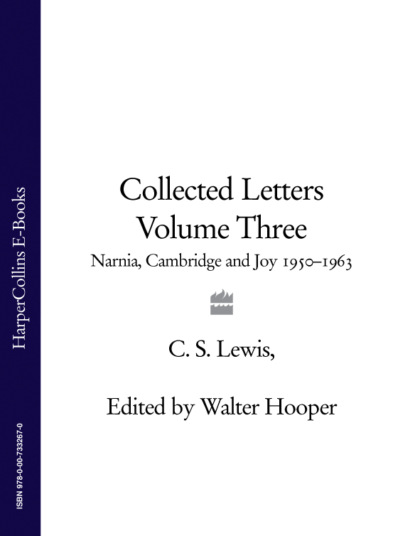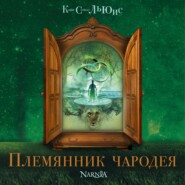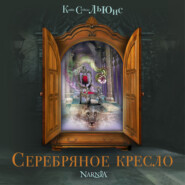По всем вопросам обращайтесь на: info@litportal.ru
(©) 2003-2025.
✖
Collected Letters Volume Three: Narnia, Cambridge and Joy 1950–1963
Настройки чтения
Размер шрифта
Высота строк
Поля
112 (#ulink_0072e41c-0d2c-55b5-9e31-43c9e22d03c1) Skinner, The Return of Arthur: Merlin, II, ii, 5.
113 (#ulink_0072e41c-0d2c-55b5-9e31-43c9e22d03c1) ibid., xxxvii.
114 (#ulink_0072e41c-0d2c-55b5-9e31-43c9e22d03c1) Stanza.
115 (#ulink_0072e41c-0d2c-55b5-9e31-43c9e22d03c1) ibid., Ill, ix. ‘Lasciate etc’ refers to Dante, Inferno, III, 9.
116 (#ulink_f69e4046-cfb9-5de5-8b8c-648560a91dec) Sir Desmond MacCarthy (1877-1952), literary journalist, was known for his theatre criticism and for his reviews and other writing in the Sunday Times.
117 (#ulink_d718ef8f-c1ce-5a1f-a964-e81e364ca45c) In C. S. Lewis: Apostle to the Skeptics, ch. 20, p. 161, Walsh stated: ‘I mention what Lewis has not done, not as a reproach to him, but to suggest to his overardent admirers that an exclusive diet of his works is not wholesome.’
118 (#ulink_e69079ef-470b-56a5-a94d-7eae85774458) Genia Goelz—Mrs E. L. Goelz—was the daughter of Mrs Mary Van Deusen. She is referred to as ‘Mrs Sonia Graham’ in L. She was writing from 2756 Reese Avenue, Evanston, Illinois. Although abbreviated copies of the letters to Mrs Goelz appeared in L, complete copies were made by Walter Hooper in 1965.
119 (#ulink_579e3db8-46da-5173-ab68-7964f502b78a) Mary Elizabeth ‘Lily Ewart was Greeves’s sister. See her biography in CL I, p. 98n.
120 (#ulink_aae502eb-af6d-539a-a012-a2dbf4a18d92) Dr Firor had a ranch in Wyoming, and he was constantly urging Lewis to join him there.
121 (#ulink_aae502eb-af6d-539a-a012-a2dbf4a18d92) In The Great Divorce: A Dream (London: Bles, 1945 [1946]; Fount, 1997), ch. 11, one of the Ghosts has on his shoulder a Red Lizard who represents Lust.
122 (#ulink_ef6d2c8f-c371-565a-8a1b-12e44eefece5) Robert C. Walton, head of the BBC’s School Broadcasting Department, wrote to Lewis on 9 July 1951 announcing plans for six half-hour programmes on ‘the nature of evidence’: ‘We shall begin by stating as clearly as possible the Christian belief that God is to be understood in personal terms, and then two speakers will discuss with the “interrogator” how they have come to accept the Christian conception of God’s nature. Our main purpose is not to argue whether or not the Christian belief is true, but to explain the nature of the evidence which leads Christians to this conclusion. We should be very glad if you would take part in this programme.’
123 (#ulink_77b2d8c7-25b6-5443-a8cf-a4500133cf9c) The old white cobra in ‘The King’s Ankus’ in Kipling’s Second Jungle Book (1895).
124 (#ulink_48fadf68-2f17-5355-87f0-1ff0e8a3975a) Sir David Lyndsay, The Monarchie (Ane Dialog Betwix Experience and ane Courteour) (1554), 1293-4.
125 (#ulink_8b7c903c-0f9c-5897-9069-a05f2dc7fde1) This letter was first published in the Church Times, CXXXIV (10 August 1951), p. 541, under the title ‘The Holy Name’.
126 (#ulink_d40451c6-799c-508b-bb4e-d96f8dcb59cf) Leslie E. T. Bradbury, ‘The Holy Name’, Church Times, CXXXIV (3 August 1951), p. 525.
127 (#ulink_2110200b-1189-5df8-a0c1-48e153b0d550) See the biography of Idrisyn Oliver Evans in CLII, p. 584n.
128 (#ulink_9d6ada8f-71db-5b6f-86c7-e5964803b967) I. O. Evans, The Coming of a King: A Story of the Stone Age (1950).
129 (#ulink_efb405bc-e841-5718-84c5-8f87d75c3a82) Mrs Vulliamy was writing from Park College, Parksville, Missouri.
130 (#ulink_3ceed007-7a29-5cfe-a890-442f8ca4b526) Lewis’s doctor, Robert Emlyn ‘Humphrey Havard.
131 (#ulink_33404ef2-cd76-5ca5-a0f9-3f7d2982d090) Acts 9:4-5: ‘And he fell to the earth, and heard a voice saying unto him, Saul, Saul, why persecutest thou me? And he said, Who are thou, Lord? And the Lord said, I am Jesus whom thou persecutes’
132 (#ulink_33404ef2-cd76-5ca5-a0f9-3f7d2982d090) Colossians 1:23-4: ‘I Paul…now rejoice in my sufferings for you, and fill up that which is behind of the afflictions of Christ in my flesh for his body’s sake, which is the church.’
133 (#ulink_33404ef2-cd76-5ca5-a0f9-3f7d2982d090) Romans 12:5: ‘So we, being many, are one body in Christ, and every one members one of another.’
134 (#ulink_08ec5391-9750-5c1f-9e83-e0d4d1fcf10d) Lewis was referring to a problem that sometimes arises when, in a family of non-Christians, one of them becomes a Christian. It is one of the themes in Lewis’s novel, Till We Have Faces. See the letter to Clyde Kilby of 10 February 1957.
135 (#ulink_08ec5391-9750-5c1f-9e83-e0d4d1fcf10d) Lewis meant ‘The Coming of Galahad’ in Charles Williams’s Taliessin Through Logres (1938).
136 (#ulink_08ec5391-9750-5c1f-9e83-e0d4d1fcf10d) Luke 12:49-53: Suppose ye that I am come to give peace on earth? I tell you, Nay; but rather division: For from henceforth there shall be five in one house divided, three against two, and two against three. The father shall be divided against the son, and the son against the father; the mother against the daughter, and the daughter against the mother; the mother in law against her daughter in law, and the daughter in law against her mother in law.’
* (#ulink_27513fd8-7a0f-5730-88d0-fb6025c16718) Yet oh! How I sympathise with him! God is such an Intruder! We must deal with them v. tenderly.
137 (#ulink_29ba91f6-f002-590a-97dd-31d9a3240a8e)Francis of Assist: Early Documents, 3 vols., ed. Regis J. Armstrong OFM Cap., J. A. Wayne Hellmann OFM, Conv., William J. Short OFM (New York: New City Press, 2000), Vol. II: The Founder, ‘The Legends and Sermons about Saint Francis by Bonaventure of Bagnoregio (1255-1267)’, p. 564: ‘[Francis of Assisi] taught his brothers…that they should master their rebellious and lazy flesh by constant discipline and useful work. Therefore he used to call his body Brother Ass, for he felt it should be subjected to heavy labor, beaten frequently with whips, and fed with the poorest food.’
138 (#ulink_4fbff2df-f33b-518e-9871-331d7e4cbb2b) This was the Italian translation of Out of the Silent Planet, published as Lontano dal Pianeta Silenzioso, trans. Franca Degli Espinosa (Milan and Verona: Mandadori, 1951).
139 (#ulink_b806a9ef-f9de-5c92-a9bf-f79c82942d41) See the biography of Bernard Acworth in CL II, p. 632n. Acworth was founder and president emeritus of the Evolution Protest Movement.
140 (#ulink_650f013c-320e-585a-9b83-60d8e8da7b12) Bernard Acworth, This Progress: The Tragedy of Evolution (London: Rich & Cowan, 1934).
141 (#ulink_005ba236-92d9-5acc-8cdd-594b9968dcf7) The tomb of Boethius (AD 480-524) is in the Church of S. Pietro Ciel d’Oro at Pavia.
142 (#ulink_005ba236-92d9-5acc-8cdd-594b9968dcf7) The edition Lewis used was The Consolation of Philosophy, with the English Translation of ‘I.T.’ (1609), rev. H. E Stewart (London: Heinemann, Loeb Classical Library, 1918).
143 (#ulink_d870c1fb-f84b-524c-a645-99894c717d36) Kinter had asked about a sentence in the preface of Lewis’s That Hideous Strength: A Modern Fairy-Tale for Grown-Ups (London: John Lane, 1945; HarperCollins, 2000), p. xii: ‘Those who would like to learn further about Numinor and the True West must (alas!) await the publication of much that still exists only in the MSS. of my friend, Professor J. R. R. Tolkien.’
144 (#ulink_d870c1fb-f84b-524c-a645-99894c717d36) Max M”uller, The Science of Language, 2 vols. (London: Longmans, 1891), Vol. II, p. 454.
145 (#ulink_3cddde34-494b-566a-96ef-b9e6c556b8a9) George MacDonald, Sir Gibbie (1879), ch. 47: ‘the time for speaking comes rarely, the time for being never departs.’
146 (#ulink_91f64bb7-53ab-5781-b2b2-fe02789acc2d) Wendell W. Watters, MD, a Canadian psychiatrist, was Professor of Psychiatry at McMaster University, Hamilton, Ontario, Canada. He was the author of Deadly Doctrine: Health, Illness, and Christian God-talk (1992).
147 (#ulink_91f64bb7-53ab-5781-b2b2-fe02789acc2d) This letter first appeared in L as ‘To A CRITICAL BUT CHARITABLE READER’, and was incorrectly dated 12 September 1951.
148 (#ulink_c6b96873-6072-5b4d-b4bf-7af88e8a5e20) Dr Watters’s objection to Christ’s ‘unfair advantage’ was occasioned by Lewis’s Broadcast Talks, Bk. II, ch. 4. When revising the talks for Mere Christianity (London: Bles, 1952; HarperCollins, 2002), Lewis added two paragraphs to the end of Book II, Chapter 4, in which he used the example given here: ‘I have heard some people complain that if lesus was God as well as man, then His sufferings and death lose all value in their eyes, “because it must have been so easy for him”…If I am drowning in a rapid river, a man who still has one foot on the bank may give me a hand which saves my life. Ought I to shout back (between my gasps) “No, it’s not fair! You have an advantage! You’re keeping one foot on the bank”? That advantage—call it “unfair” if you like—is the only reason why he can be of any use to me. To what will you look for help if you will not look to that which is stronger than yourself?’ (pp. 58-9)
149 (#ulink_98f195e2-3242-52e5-a815-44b48cf5f2ff) Geoffrey Bles was pressing Blamires to persuade Lewis to write a preface for Blamires’s English in Education (London: Bles, 1951).
150 (#ulink_98f195e2-3242-52e5-a815-44b48cf5f2ff) i.e., the preface he was writing for D. E. Harding’s The Hierarchy of Heaven and Earth.
151 (#ulink_f503de38-04d4-59f7-8b2f-e63b5c01d478) See the biography of Herbert Palmer, poet and literary critic, in CL II, p. 678n.
152 (#ulink_dc46e410-eefb-5c0a-a9b3-5b02c6a497a6) John Milton, Prose Works, with preliminary remarks and notes by J. A. St John, 5 vols. (London: Bohn’s Standard Library, 1948-53).
153 (#ulink_1b2a2b41-2fb5-5d58-b01e-6968df9258be) Herbert Palmer, ‘English Poetry: 1938-1950–I’, The Fortnightly, CLXX (September 1951), pp. 624-8; ‘English Poetry: 1938-1950–II’, ibid. (October 1951), pp. 695-700; ‘English Poetry: 1938-1950–III’, ibid. (October 1951), pp. 768-74.
155 (#ulink_aa4af86c-a7c8-5389-8959-3102fb8fcb8b) i.e., The Problem of Pain.
156 (#ulink_aa4af86c-a7c8-5389-8959-3102fb8fcb8b) Ashley Sampson of Geoffrey Bles, The Centenary Press, had asked Lewis to contribute a book on pain to the Christian Challenge series. See CL II, p. 289n.
157 (#ulink_33d138c6-9b85-5888-8975-807591e26d42)The Problem of Pain, ch. 1, p. 15: ‘The Christian faith…has the master touch–the rough, male taste of reality’
158 (#ulink_1a7efdde-88a3-56ae-b4dc-f4a5a512b31c) ‘C. S. Lewis: 1898-1963’, Bodleian Library, MS. Facs. d. 290.
159 (#ulink_9798517e-d044-597b-9a5d-875d67145268) Since the thirteenth century there have been many versions of the legend of the Wandering Jew. In essence the legend recounts how a Jew chided Christ as he bore the cross to Calvary and was thereafter condemned to wander about the world until Christ’s Second Coming.
160 (#ulink_6a824c32-9bfe-5ea9-9e74-ed8a98f4477e) Bunyan, The Pilgrim’s Progress, Part I, pp. 55-6.
161 (#ulink_d6b9bcd4-3c00-59e1-998f-d129e792fe7c) United Nations Organization.

















